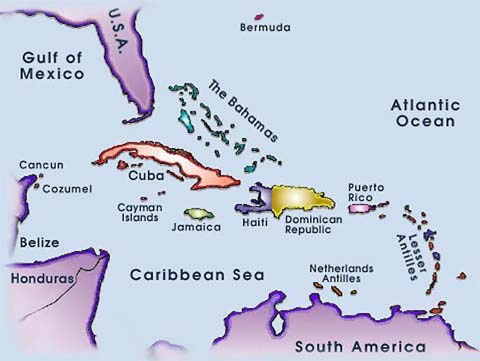 |
- GDP
- composition by sector: agriculture: 7.4% industry: 42.1%
services: 50.5% (1997 est.)
- POPULATION
below poverty line: 34.2% (1992 est.)
- LABOR
FORCE :
1.13 million (1998)
- Labor
force - by occupation: services 60%, agriculture 21%,
industry 19% (1998)
- UNEMPLOYMENT
RATE : 15.5% (1998)
- INDUSTRIES:
tourism, bauxite, textiles, food processing, light manufactures,
rum, cement, metal, paper, chemical products
- AGRICULTURE
- products: sugarcane, bananas, coffee, citrus, potatoes,
vegetables; poultry, goats, milk
- EXPORTS
-
- commodities:
alumina, bauxite, sugar, bananas, rum
- partners:
US 39.5%, EU (excluding UK) 15.6%, UK 12.1%, Canada
11.5% (1998)
- IMPORTS
-
-
commodities: machinery and transport equipment, construction
materials, fuel, food, chemicals, fertilizers
- partners:
US 50.9%, EU (excluding UK) 9.5%, Caricom countries
10.4%, Latin America 6% (1998)
- DEBT
- external: $3.8 billion (1998 est.)
- ECONOMIC
AID - recipient: $102.7 million (1995)
(www.abacci.com/atlas/demography.asp?countryID=230)
|
|
|
 |
- POPULATION:
2,652,689 (July 2000 est.)
- AGE
STRUCTURE: 0-14 years: 30% (male 411,448; female 392,559)
15-64 years: 63% (male 832,314; female 837,133) 65 years
and over: 7% (male 80,059; female 99,176) (2000 est.)
- POPULATION
GROWTH RATE: 0.46% (2000 est.)
- NET
MIGRATION RATE: -8.39 migrant(s)/1,000 population (2000
est.)
- ETHNIC
GROUPS: black 90.9%, East Indian 1.3%, white 0.2%, Chinese
0.2%, mixed 7.3%, other 0.1%
- RELIGIONS:
Protestant 61.3% (Church of God 21.2%, Baptist 8.8%, Anglican
5.5%, Seventh-Day Adventist 9%, Pentecostal 7.6%, Methodist
2.7%, United Church 2.7%, Brethren 1.1%, Jehovah's Witness
1.6%, Moravian 1.1%), Roman Catholic 4%, other, including
some spiritual cults 34.7%
- LANGUAGES:
English, Creole
- LITERACY:
definition: age 15 and over has ever attended school total
population: 85% male: 80.8% female: 89.1% (1995 est.)
(www.abacci.com/atlas/demography.asp?countryID=230)
|
| |
|
|
 |
|
Government
efforts in conservation and reef management have been increasingly
supplemented by NGO (non-governmental organization) activities.
These include:
- Local
groups have formed all around the country, and several are
doing valuable work in the coastal zone (Negril Coral Reef
Preservation Society, Portland Environmental Protection
Association, St. Ann Environmental Protection Association,
and Caribbean Coastal Area Management Foundation).
- Marine
Parks and Environmental Protection Areas:
- Ocho
Rios Underwater Park 1966; Montego
Bay Marine Park 1989; Negril Marine Park 1998; Bowden
Fish Sanctuary; Palisadoes/Port Royal Protected Area
1998; Portland Bight Protected Area 1999.
-
The Fisheries Improvement Programme, at the Discovery Bay
Marine Laboratory, is helping artisanal fishermen to manage
their own fishery resources.
- The
CARICOMP monitoring site at Discovery Bay is soon to be
joined by others at Portland Bight and Montego Bay.
- Long-term
monitoring for the effects of climate change is to be carried
out for the Caribbean Planning for Adaptation to Climate
Change project.
(
www.aims.gov.au/pages/research/coral-bleaching/scr1998/scr-10.html;
Woodley, 2000) |
|
|
 |
|
Management
of Jamaica's coral reefs was limited until the early 1990s.
Lack of funding and staff was frequently reported as the cause.
Currently key laws have been put into place to manage the
Jamaican coast and its precious reefs.
- 1960,
Beach Control Act. Main law controlling coastal development,
which licensed construction or drainage works near the shore.
However, it was easy to ignore.
- 1991,
Natural Resources Conservation Authority (NRCA) Act started
a process of rationalisation and obliged public sectors
to comply.
- 1998,
Council
on Ocean and Coastal Zone Management formed and reports
directly to Cabinet. Increases potential for better integration
of coastal zone management.
- 2000,
National Environmental Planning Agency formed via merger
of NRCA with Town Planning Department and the Land Development
Commission.
(
www.aims.gov.au/pages/research/coral-bleaching/scr1998/scr-10.html;
Woodley, 2000)
|
|
|
|
This web
site was created by Lynn Tran at the North Carolina State University, Department
of Mathematics, Science, and Technology Education on 7/12/03. Faculty advisor
Dr. David Eggleston, NCSU, Department of Marine, Earth, & Atmospheric Sciences.
Last updated
December 29, 2003
.
|
